|
Back
Murder in the Cathedral New York
Cathedral of St. John the Divine
05/29/2017 -
Gustav Mahler: Symphony No. 4
Ying Fang (Soprano)
New York Philharmonic Orchestra, Alan Gilbert (Conductor/Music Director)

A. Gilbert, Y. Fang (© Samuel A. Dog)
“It begins as if it can’t count up to three...and finally it’s calculating dizzily in millions upon millions.”
Gustav Mahler, describing the opening sleigh bells of his Fourth Symphony
The joy of hearing Alan Gilbert’s final “Annual Free Memorial Day Concert” in the vast Cathedral of St. John the Divine was of course bittersweet, since he is leaving the New York Philharmonic. Tributes to his decade here will be multifarious, and, if hagiographic, will be honestly merited. He still has a few concerts to go, but these annual celebrations, the beginning of New York’s summer season of free events, are spatially special and bring together a most diverse community.
The choice this year of Mahler’s Fourth Symphony should have been ideal. In a year of endless amorphous military adventures, political tumult, a moral atmosphere that would make the Medicis seem like Sunday School teachers, the last thing we needed was one of Mahler’s apocalyptic pieces, or his psychoanalytical torments. What our world needed now was the simplicity of sleigh bells, the heaven of a child, ethereal radiance and the restraint of a simple melody.
In other words, Mahler’s vision of an 18th Century symphony, with all the fin de siècle trimmings! Yes, Mahler’s Fourth was not as virginal as all that, and the visions of death were ever on the forefront. But the surface reading really does have a childlike happiness.
Wouldst that this had come about. It didn’t. Yes, Mr. Gilbert was on top form, the New York Philharmonic was playing at its best, and soprano Ying Fang performed those luscious last-movement verses admirably. Yet sitting amongst the first 20 rows of the Cathedral, it was evident from the first sleigh bells that the natural resonance was anything but an advantage for the clarity of one of the world’s great orchestral painters.
Its dimensions had been created for the ordinary concert hall. The Symphony had been written for the Cologne Concert Hall (where it was booed at its first performance), the premiere, three years later, in 1904, was in Carnegie Hall. Just as Monteverdi, Mozart. Bach and Britten had written their masses to take advantage of Baroque church grandeur and sonority, so Mahler had taken advantage of barn-like early concert-halls built to give as clear a visual picture as possible.
Mahler, in fact, had been deemed a tyrant because he never allowed music to “wash over” his audience, as in a church service. He needed clarity above all. And this was impossible in a cathedral of St. John’s dimensions.
Thus the problem here. Ironically, the Mahler quote above about the bells multiplying “into the millions” was exactly what went wrong in this performance. No matter what Mr. Gilbert could do, he couldn’t stop the music echoing over itself, that touching first tune transformed to a series of tunes, the French horn solos resembling a chorus of hunting horns in a haunted forest.
That first movement, in fact, would have been baffling for a first-time listener. Why were the strings climbing over one another? Why were the bells less twinkling and more tingling? And why did these easy Classical-style divisions merge into one? Add to this Mr. Gilbert’s penchant here for the dramatic rubato, which was less a pause than a moment for all the echoes to jam in an ensemble.
Not to worry, though. Throughout the movement, the softer sections were relatively clear, and the woodwind solos became clarions against the masses of the orchestra.
The next two movements were either far better, or one became used to the tricky acoustics. The string chorales become more reverent, and Concertmaster Frank Huang gave a vivacious solo with his “out-of-tune” fiddle. In fact, this was the first time I could hear that second-hand fiddle play a duet with “regular” violinist Sheryl Staples, where the distortion was like a delicious joke. The sumptuous slow movement was as warm as possible. But the climax–that whirling full-orchestra chord with the brass coming up behind–was less a radiant surprise than another full-ensemble tapestry.
(The one man-made fault here was that soloist Ying Fang entered right in the middle of this great climax. What should have been an angelic vision in white became a distraction.)
Nothing was distorted in this finale. This listener prefers a more naive reading a simpler, more serene voice. Ms. Fang is an operatic soprano. Yet her natural beauty and vocal training were all too evident here. Mr. Gilbert rightly waited a good 30 seconds before turning around for the applause.
And while the sounds of the Cathedral were not the sounds of Mahler, Alan Gilbert acquitted himself as well as could be expected. June brings a few more performances by the Maestro, inside David Geffen Hall, where he rightly–more than rightly– belongs.
Harry Rolnck
|